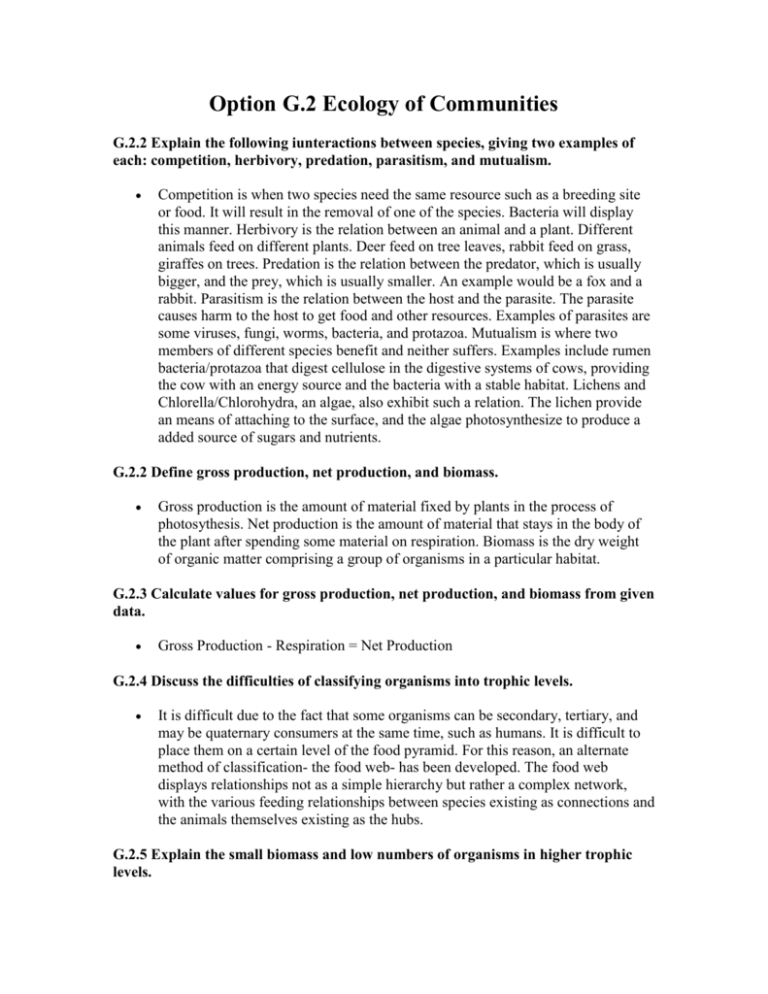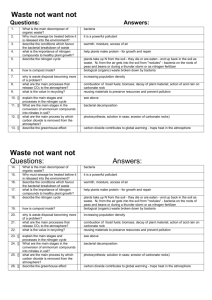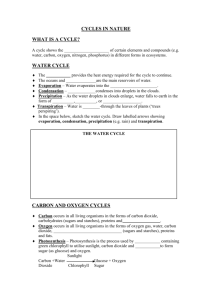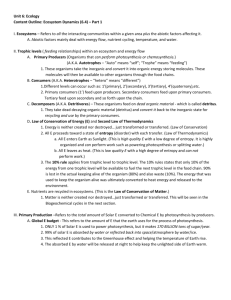Biology Option G
advertisement

Option G.2 Ecology of Communities G.2.2 Explain the following iunteractions between species, giving two examples of each: competition, herbivory, predation, parasitism, and mutualism. Competition is when two species need the same resource such as a breeding site or food. It will result in the removal of one of the species. Bacteria will display this manner. Herbivory is the relation between an animal and a plant. Different animals feed on different plants. Deer feed on tree leaves, rabbit feed on grass, giraffes on trees. Predation is the relation between the predator, which is usually bigger, and the prey, which is usually smaller. An example would be a fox and a rabbit. Parasitism is the relation between the host and the parasite. The parasite causes harm to the host to get food and other resources. Examples of parasites are some viruses, fungi, worms, bacteria, and protazoa. Mutualism is where two members of different species benefit and neither suffers. Examples include rumen bacteria/protazoa that digest cellulose in the digestive systems of cows, providing the cow with an energy source and the bacteria with a stable habitat. Lichens and Chlorella/Chlorohydra, an algae, also exhibit such a relation. The lichen provide an means of attaching to the surface, and the algae photosynthesize to produce a added source of sugars and nutrients. G.2.2 Define gross production, net production, and biomass. Gross production is the amount of material fixed by plants in the process of photosythesis. Net production is the amount of material that stays in the body of the plant after spending some material on respiration. Biomass is the dry weight of organic matter comprising a group of organisms in a particular habitat. G.2.3 Calculate values for gross production, net production, and biomass from given data. Gross Production - Respiration = Net Production G.2.4 Discuss the difficulties of classifying organisms into trophic levels. It is difficult due to the fact that some organisms can be secondary, tertiary, and may be quaternary consumers at the same time, such as humans. It is difficult to place them on a certain level of the food pyramid. For this reason, an alternate method of classification- the food web- has been developed. The food web displays relationships not as a simple hierarchy but rather a complex network, with the various feeding relationships between species existing as connections and the animals themselves existing as the hubs. G.2.5 Explain the small biomass and low numbers of organisms in higher trophic levels. There is small amount of organisms in the higher trophic levels because as the levels get higher, the amount of energy from feeding on the level below them is very low, making it difficult to survive. Energy is lost between levels in the form of heat (respiration), waste, and death. G.2.6 Construct a pyramid of energy given appropriate information. The lowest bar of the pyramid of energy represents gross primary productivity, the next bar is the energy ingested as food by primary consumers, and so on. The units are energy per unit area per unit time. G.2.7 Describe ecological succession using one example Ecological succession is the gradual change in the composition of a community with time in an ecosystem. If succession occurs in a lifeless area, it is primary succession. It can start after things such as volcanoes, fire or flood. Lichens inhabit a rock and over time, the face of the rock changes. This makes the rock now inviting to mosses. Later, ferns arrive through the activity of their roots, causing furthur changes to the rock, so soil formation starts to occur. Then flowering trees grow, then conifers, and other larger trees. G.2.8 Explain the effects of living organisms on the abiotic environment with reference to the changes occurring during ecological succession to climax communities. Living organisms can help with soil development, as a plant grows, their roots grow deeper down and break rock into small particles, helping soil formation. Plants enrich the soil with minerals as they die and decompose. The plant roots hold the soil particles together, preventing soil erosion. Plants can grow heavily in a certain area that might result in blocking river flow and altering its direction. Plants can contribute to the water cycle through the process of transpiration. The water that evaporates from the leaves condenses and comes down in the form of rain. The presence of organic materials in the soil and the presence of roots and root hair help in the retention of water and slows down drainage. Option G.3 Biodiversity and Conservation G.3.1 Discuss reasons for the conservation of biodiversity using rainforests as an example. Reasons should include ethical, ecological, economic, and aesthetic arguments. Biodiversity is highest in the tropical rainforests. Ethical reasons for conserving biodiversity are that all species have a right to live on this planet. Ecological reasons are that species live with great interaction and dependence on each other. If one species dies out, a food chain is disrupted, therefore disrupting all of the other species as well. Aesthetic reasons are that the tropical rain forest is one of the most beautiful attractions on this planet. There is variety everywhere in the rainforest. Economic reasons are that the rainforest is a source of materials important to human life. Medicinal substances can be taken from a veriety of plants in the rain forest, and ecotourism offers a new source of funds for the many impoverished nations these forests exist in. G.3.2 Outline the factors that caused the extincion of one named animal and one named plant species. The Arizona Jaguar became extinct due to an increased demand for its fur. As the human population increased in the areas inhabited by the jaguar, the hunting and shooting increased and the last of this rare animal was shot in 1905 in New Mexico. The Fluffy groundsel is a kind of herbal plant with clusters of yellow flowers. It became extinct because of farming, building, road construction and other sorts of human impact in the American Soutwest. G.3.3 Outline the use of the Simpson diversity index. D = (N(N-1))/(summation of n(n-1)). D is the diversity index, N is the total number of organisms of all species found, n is the number of individuals of a particular species. The Simpson diversity index is a measure of species richness. A high value of D suggests a stable and ancient site and a low D value could suggest pollution, recent colonization or agricultural management. The index is mormally used in studies of vegetation but can also be applied to comparisons of animal (or even all species) diversity. G.3.4 Explain the use of biotic indices and indicator species in monitoring environmental change. Indicator species are highly sensitive to environmental changes and their populations increase or decrease significantly depending on changes in the enironment. It is a good indicator of change. Biotic indices, the numbers of organisms in the indicator species populations, can be measured directly so they are easy to keep track of. G.3.5 Outline the damage caused to marine ecosystems by the over-exploitation of fish. If the population of fish is overexploited and the number of adult fish fall below a critical level, spawning fails witch can destroy the fish industry and the fish population. G.3.6 Discuss the international measures that would promote the conservation of fish. International measures that could be taken are monitoring of stocks and of reproduction rates, quotas for catches of species with low stocks, moratoria on catching endangered species, minimum net sizes, so that immature fish are not caught, and banning of drift nets, which catch many different species of fish indiscriminately. G.3.7 Discuss the advantages of in situ conservation of endangered species (terrestrial and aquatic nature reserves). These are places where the animal is found in its own natural habitat and is not allowed to be overtaken by humans and their activities. This keeps the animals out of danger zones and allows them to live and reproduce naturally in its own environment. Most animals typically tend to survive at a much greater rate using in situ conservation, and preserving their habitat allows other species to live there also, thus preserving other animals and biodiversity. G.3.8 Outline the management of nature reserves. A nature reserve is maintained by controlling alien species. Those that are not originally supposed to be in the area are not allowed to be in there. They restore degraded areas where human impact has destroyed the ecosystem by methods such as reforestation and species reintroduction. They promote the recovery of threatened species. They also control the exploitation by humans. Logging is controlled along with land clearing. If trees are cut down, more are planted. G.3.9 Outline the use of ex situ conservation measures including captive breeding of animals, botanic gardens, and seed banks. For captive breeding, animals kept in zoos or parks are allowed to reproduce in order to give them a chance to increase in number, with the possibility of eventually releasing some of the offspring into the wild. Botanic gardins are where most of the known plant species are planted in controlled environments to maintain their species. Seed banks are where seeds are kept, since they stay in good condition for thousands of years. G.3.10 Discuss the role of international agencies and conservation measures including CITES and WWF. The IUCN works on conserving biological diversity and protecting species and their habitats. CITES aims to control and regulate cross-border trade in wildlife and wildlife products. WWF attempts to save biodiversity and wildlife. They try to keep areas clear of being cut down by buying large pieces of land and establish them as nature reserves. In Rio de Janeiro, a convention was held to discuss and begin to conserve biological diversity, and to sustain use of its components and the fair sharing of the benefits arising from its utilization (including genetic resources). Option G.4 The Nitrogen Cycle G.4.1 State that all chemical elements occuring in organisms are part of biogeochemical cycles and that these cycles involve water, land and the atmosphere. All chemical elements occuring in organisms are part of biogeochemical cycles and these cycles involve water, land and the atmosphere. G.4.2 Explain that all biogeochemical cycles summarize the movement of elements through the biological components of ecosystems (food chains) to form complex organic molecules, and subsequently simpler inorganic forms which can be used again. Biogeochemical cycles are the cycling of compounds in an ecosystem. Free nitrogen, biomass nitrate, that goes into plants and bacteria through the process of nitrogen fixation. Other bacteria also release free nitrogen back into the air. If plants die, deamination occurs, ammonia is formed, oxidation occurs, nitrate is formed, more oxidation occurs, more nitrate is formed, then it can follow this path through another plant again or go to bacteria. This nitrogen cycle is not the only one present in an ecosystem that returns complex molecules to simple and simple to complex over and over again. The vast majority of other organic substances, such as amino acids, also are recycled in this manner, thus allowing ecosystems to survive without a constant influx of new organisms or nutrients. G.4.3 Explain that chemoautotrophs can oxidize inorganic substances as a direct energy source to synthesize ATP. o Only bacteria can make their food through chemoautotrophy. They create chemical reactions utilizing inorganic substances, such as nitrates, ammonia and sulfur. The oxidization of these substances results in energy. The energy is then used to fix carbon dioxide into glucose. G.4.4 State that chemoautotrophy is found only among bacteria. o Chemoautotrophy is found only among bacteria. G.4.5 Draw a diagram of a nitrogen cycle. o Drawing will be inserted at a later date. G.4.6 Outline the roles of Rhizobium, Azobacter, Nitrosomonous, Nitrobacter and Pseudomonas dentrificans in the nitrogen cycle. o Rhizobium is a nirogen fixing bacteria that can create nitrate. Azobacter does the same thing. Nitosomonous oxidizes ammonia to form nitrite. Nitrobacter oxidizes nitrite to form nitrate. Pseudomonas is a dentrifying bacteria that creates free nitrogen in the air from nitrate. The first four of these take inorganic nitrogen compounds found in the soil and transform them into a substance that can be used by plants. The last serves the same purpose- cycling nitrogen out of the soil- but instead transforms nitrogen compounds in the soil into atmospheric nitrogen. G.4.7 Describe the conditions that favor dentrification and nitrification. o A harmful type of bacteria is called dentrifying bacteria. This breaks nitrate into free nitrogen. This decreases soil fertility and plant growth in these soils becomes poor. This kind of bacteria is usually found in water logged soils. Water logging results in poor aeration and deficiency of oxygen in the soil. Nitrification occurs in ploughed soil because then the oxygen gets into the soil and makes it unfavorable for dentrifying bacteria. G.4.8 Discuss the action taken by farmers/gardners to increase the nitrogen fertility of the soil including fertilizers, plowing /digging and crop rotation (use of legumes). Farmers plough the soil to make air between the soil particles. The oxygen makes it an unfavorable condition for dentrifying bacteria, thus preventing them from removing nitrogen compounds needed for plant growth from the soil. Fertilizers are another option used to ensure proper nitrogen levels in the soil: processed from inorganic nitrogen, they provide a guaranteed heavy source of nitrogen compounds to plants. However, they have a tendency to leach out of the soil rapidly, and can often harm to the surrounding environment. The final method, crop rotation, involves rotating crop planting between the crop the farmer wishes to grow and some kind of legume crop. Legumes form symbiotic relationships with nitrogen-fixing bacteria, allowing these bacteria to produce their own source of nitrates from inorganic or atmospheric nitrogen. Under favorable conditions, these plants can produce enough excess nitrogen that it renews the soil's store of nitrates capable of being used by plants next year. The following year, non-legume crops are planted on the field the legumes Option G.5 Impacts of Humans on Ecosystems G.5.1 Describe the role of atmospheric ozone in absorbing ultra violet (UV) radiation. The ozone absorbs UV light, and the molecules of the ozone layer are broken into 3 oxygen atoms. The atoms of oxygen are highly reactive and they combine again to form ozone. In doing this, they release heat. This results in the conversion of UV light energy into heat energy. G.5.2 Outline the effects of UV radiaiton on living tissues and biological productivity. UV radiation can kill phytoplankton, the sea-going organisms that account for a significant portion of net photosynthesis that occurs in the biosphere. The radiation can also retard growth of terrestrial plants by slowing their rate of photosynthesis, usually a result of radiative damage and subsequent mutations caused in plant leaves. High levels of UV light can also kill symbiotic bacteria that fixes nitrogen in the root nodules of legumes. UV rays cause skin cancer in humans in prolonged exposure or in very high dosages, and can also weaken and potentially destroy the cells of the immune system. G.5.3 Outline the chemical effect of chlorine on the ozone layer. Chlorine reacts with ozone and breaks it irreversibly into oxygen. One chlorine can break thousands of ozone molecules. This leads to depletion of the ozone layer and the passage of UV light through the ozone hole. G.5.4 Discuss methods of reducing the manufacture and release of ozone depleting substances including recycling refrigerants, reducing production of gas-blown plastics and using CFC-free propellants. To reduce the release of ozone depleting substances, filters can be fitted on factory chimneys to absorb and react with gases before they escape into the atmosphere, desulfurisation (removal of sulfur) of gases before they are emitted into the atmosphere, using alternative sources of energy such as wind, hycroelectric, waves, solar, tidal, geothermal and others, use of methane and alcohol as fuels since they do not release sulfur and other harmful gases into the atmosphere. Two of the largest sources of ozone-depleting substances come from the production of recycling refrigerants and the use of chlorfluorocarbons (CFCs) for propellants in spray cans, hairspray, etc. In order to reduce these sources, a ban on CFC-based propllents has been enacted, and most corporations now recycle the refrigerants used rather than produce entirely new ones. G.5.5 Outline the consequences of releasing raw sewage and nitrate fertilizer into rivers. Water polluted by raw sewage and nitrate fertilizers will become rich in nutrients (called eutrophication). The algae absorb large amounts of nitrates and this results in a quick growth and reproduction of these algae and so the ecosystem becomes overpopulated with algae (algal blooms). This blocks the sun from reaching the photosynthesizers at deeper levels and blocks the entry of carbon dioxide and oxygen from the atmosphere. The algae hit their carrying capacity and start to die quickly encouraging the growth of bacteria which increase the biochemical oxygen demand. They consume a large amount of oxygen and this results in deoxygenation and aerobic organisms starts to die. Finally, anaerobic bacteria such as disease causing bacteria and some parasties come in. This makes it a bad spot for anything to survive in. Raw sewages can also release pathogens into the bathing and drinking water supplies, causing the risk of human and animal infection when this water is used. G.5.6 Outline the origin, formation and biological consequences of acid precipitation on plants and animals. Acid precipitation occurs primarily because of the presence in the atmosphere of sulfur oxides and nitrogen oxides that react with water in the air to form acids. It can come from smokestacks and industries. Once it falls, it can affect the solubility of minerals in the soil. It can lower the pH of lakes and contaminate freshwater habitats. It affects fish, amphibians and aquatic invertabrates the most, due to the destruction of their freshwater lake and river environment. G.5.7 State that biomass can be used as a source of fuels such as methane and ethanol. Biomass can be used as a source of fuels such as methane and ethanol. G.5.8 Explain the principles involved in the generation of methane from biomass, including the conditions needed, organisms involved and the basic chemical reactions that occur. Organic rubbish such as remains of food, are placed in a sealed container. Methanogenic bacteria such as methanobacillus and methanococcus are added. The container must be sealed to ensure anaerobic reactions. Bacteria decompose organic material in the rubbish to methanoate, ethanoate or methanol. Bacteria use these things as a source of hydrogen (electrons). The hydrogen is used to reduce carbon dioxide into methane. The methane is then released. This can be a source of fuel in factories and industries. o previously grown on.









